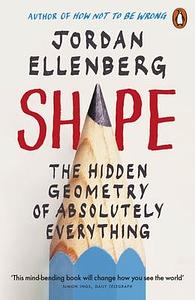Take a photo of a barcode or cover
challenging
informative
slow-paced
A glorious intellectual feast & mind-expanding brain workout, exuberantly presented
Once upon a time, back in college, there was a kid who was winning not just all the awards in mathematics (and by "awards" I mean "top prizes in worldwide competition"), but also in writing. How can anyone be that good at both? That kid has since been teaching math as a college professor for 20+ years, and written a new book. Would you be interested in reading a book on math by the best combination mathematician-writer I know? I think you should, 'cause it's pretty damn good!
Note that Shape is probably not beach reading for most people. It's the mental equivalent of a high-intensity interval training workout: challenging and rewarding. I initially felt myself protesting when I started reading it because Jordan was actually making my brain do work. How dare you make me think! But gradually, I came to appreciate the magnitude of the intellectual journey he was taking us on, and merrily hopped on the train.
At its core, Shape is about the underlying patterns of how the world works, and the beauty of how they connect together. Take the shape of a tree, for example. It underlies not just the familiar family tree and company org chart, but also decision trees that allow you to craft winning strategies in real-life games and magically effective tools like artificial intelligence. (Also, trees.)
What I appreciated most about Shape was that it forced me to dust off the intellectual cobwebs in my brain and fill holes in my incomplete education. I didn't even realize that I only had half-assed notions of what squaring the circle, Markov chains, neural networks and eigenvalues meant — a case of the "it sounds familiar and I kind of studied it therefore I must know it" fallacy. Now, not only do I have a much better understanding of these concepts, but I also know whence they came and how they fit into the world.
That's because Ellenberg also provides the whole historical matrix of who came up with an idea, whose work motivated it in the first place, who else came up with the idea in another context, and how it's relevant today. This makes for a strangely satisfying intellectual tapestry, a visual representation of which Ellenberg is kind enough to provide. Other things I like about this book:
• Ellenberg is not afraid of going into the historical weeds. He leaves no stone unturned, probably digging up original programs from the 1904 St Louis World Fair, finding an obscure letter in the 1905 issue of "Nature", and scoring an interview with Euclid himself even though he's been dead 2000 years. He places a host of richly-drawn characters in their historical context, bringing their ideas to life: Ronald Ross, the cantankerously egotistical biostatistician; Paul Erdös, the supremely eccentric itinerant mathematician; Henri Poincaré, the math god who sparked a revolution in physics; Marion Tinsley, the nigh-invincible checkers player; Einstein, Claude Shannon, Emmy Noether, and (surprise!) geometry fanboy Abraham Lincoln.
• A sense of puckish humor permeates the book. While reading, I registered a steady rate of 3.618 cph (chuckles per hour), often in response to pop & literary references: Survivor, Talking Heads, and most important, Akbar and Jeff. A skilled literary stylist, Ellenberg also threw in some well-crafted neologisms that cracked me up. Do NOT skip the footnotes; that's where 80% of the funny lives.
I will not attempt to summarize the book's content, because it is so dense with ideas as to be incompressible. Want to learn about machine learning, epidemics, biostatistics, game theory, Google search algorithms, Heisenberg's Uncertainty Principle, neural nets, cryptography, and how they're all interconnected? It's all in there, explained in a way that felt like encountering the ideas for the first time, usually because I was.
This is because Ellenberg is an educator at heart, and a very skilled one. In the spirit of his prior book, How Not to Be Wrong, Shape is a paean to rigorous thinking: "The ultimate reason for teaching kids to write a proof is not that the world is full of proofs. It’s that the world is full of non-proofs, and grown-ups need to know the difference. It’s hard to settle for a non-proof once you’ve really familiarized yourself with the genuine article."
In a world overrun by disinformation and sloppy thinking, Shape is the antithesis: the genuine article. It joyously (and rigorously) guides you down paths of bullshit-proof reasoning with precise language, delivering you to the Land of A-ha. The book expanded my mind, giving me a whole new paradigm for looking at the world — think geometry, baby! In the process, it awakened parts of my brain so dormant from disuse, I didn't even know they still existed. Get into Shape to get your own brain in shape.
-- Ali Binazir, M.D., M.Phil., Happiness Engineer and author of [b: The Tao of Dating: The Smart Woman's Guide to Being Absolutely Irresistible|33977456|The Tao of Dating The Smart Woman's Guide to Being Absolutely Irresistible|Ali Binazir|https://i.gr-assets.com/images/S/compressed.photo.goodreads.com/books/1485248157l/33977456._SY75_.jpg|13580088], the highest-rated dating book on Amazon, and [b: Should I Go to Medical School?: An Irreverent Guide to the Pros and Cons of a Career in Medicine|34099644|Should I Go to Medical School An Irreverent Guide to the Pros and Cons of a Career in Medicine|Ali Binazir|https://i.gr-assets.com/images/S/compressed.photo.goodreads.com/books/1486004834l/34099644._SY75_.jpg|55119946]
Once upon a time, back in college, there was a kid who was winning not just all the awards in mathematics (and by "awards" I mean "top prizes in worldwide competition"), but also in writing. How can anyone be that good at both? That kid has since been teaching math as a college professor for 20+ years, and written a new book. Would you be interested in reading a book on math by the best combination mathematician-writer I know? I think you should, 'cause it's pretty damn good!
Note that Shape is probably not beach reading for most people. It's the mental equivalent of a high-intensity interval training workout: challenging and rewarding. I initially felt myself protesting when I started reading it because Jordan was actually making my brain do work. How dare you make me think! But gradually, I came to appreciate the magnitude of the intellectual journey he was taking us on, and merrily hopped on the train.
At its core, Shape is about the underlying patterns of how the world works, and the beauty of how they connect together. Take the shape of a tree, for example. It underlies not just the familiar family tree and company org chart, but also decision trees that allow you to craft winning strategies in real-life games and magically effective tools like artificial intelligence. (Also, trees.)
What I appreciated most about Shape was that it forced me to dust off the intellectual cobwebs in my brain and fill holes in my incomplete education. I didn't even realize that I only had half-assed notions of what squaring the circle, Markov chains, neural networks and eigenvalues meant — a case of the "it sounds familiar and I kind of studied it therefore I must know it" fallacy. Now, not only do I have a much better understanding of these concepts, but I also know whence they came and how they fit into the world.
That's because Ellenberg also provides the whole historical matrix of who came up with an idea, whose work motivated it in the first place, who else came up with the idea in another context, and how it's relevant today. This makes for a strangely satisfying intellectual tapestry, a visual representation of which Ellenberg is kind enough to provide. Other things I like about this book:
• Ellenberg is not afraid of going into the historical weeds. He leaves no stone unturned, probably digging up original programs from the 1904 St Louis World Fair, finding an obscure letter in the 1905 issue of "Nature", and scoring an interview with Euclid himself even though he's been dead 2000 years. He places a host of richly-drawn characters in their historical context, bringing their ideas to life: Ronald Ross, the cantankerously egotistical biostatistician; Paul Erdös, the supremely eccentric itinerant mathematician; Henri Poincaré, the math god who sparked a revolution in physics; Marion Tinsley, the nigh-invincible checkers player; Einstein, Claude Shannon, Emmy Noether, and (surprise!) geometry fanboy Abraham Lincoln.
• A sense of puckish humor permeates the book. While reading, I registered a steady rate of 3.618 cph (chuckles per hour), often in response to pop & literary references: Survivor, Talking Heads, and most important, Akbar and Jeff. A skilled literary stylist, Ellenberg also threw in some well-crafted neologisms that cracked me up. Do NOT skip the footnotes; that's where 80% of the funny lives.
I will not attempt to summarize the book's content, because it is so dense with ideas as to be incompressible. Want to learn about machine learning, epidemics, biostatistics, game theory, Google search algorithms, Heisenberg's Uncertainty Principle, neural nets, cryptography, and how they're all interconnected? It's all in there, explained in a way that felt like encountering the ideas for the first time, usually because I was.
This is because Ellenberg is an educator at heart, and a very skilled one. In the spirit of his prior book, How Not to Be Wrong, Shape is a paean to rigorous thinking: "The ultimate reason for teaching kids to write a proof is not that the world is full of proofs. It’s that the world is full of non-proofs, and grown-ups need to know the difference. It’s hard to settle for a non-proof once you’ve really familiarized yourself with the genuine article."
In a world overrun by disinformation and sloppy thinking, Shape is the antithesis: the genuine article. It joyously (and rigorously) guides you down paths of bullshit-proof reasoning with precise language, delivering you to the Land of A-ha. The book expanded my mind, giving me a whole new paradigm for looking at the world — think geometry, baby! In the process, it awakened parts of my brain so dormant from disuse, I didn't even know they still existed. Get into Shape to get your own brain in shape.
-- Ali Binazir, M.D., M.Phil., Happiness Engineer and author of [b: The Tao of Dating: The Smart Woman's Guide to Being Absolutely Irresistible|33977456|The Tao of Dating The Smart Woman's Guide to Being Absolutely Irresistible|Ali Binazir|https://i.gr-assets.com/images/S/compressed.photo.goodreads.com/books/1485248157l/33977456._SY75_.jpg|13580088], the highest-rated dating book on Amazon, and [b: Should I Go to Medical School?: An Irreverent Guide to the Pros and Cons of a Career in Medicine|34099644|Should I Go to Medical School An Irreverent Guide to the Pros and Cons of a Career in Medicine|Ali Binazir|https://i.gr-assets.com/images/S/compressed.photo.goodreads.com/books/1486004834l/34099644._SY75_.jpg|55119946]
informative
slow-paced
adventurous
challenging
informative
slow-paced
It’s really hard for a writer to make math, let alone geometry, a fun and inviting subject. Ellenberg does about as good a job as possible for those not well versed in this area (even after taking courses up to Calc V and diff equations in college I am not familiar with most of his topics in any sort of depth). His style keeps the reader engaged, although some of the concepts still get a bit tough to meticulously follow such as the larger portion near the end on jerrymandering. The charts and figures in the book do help somewhat and would have been difficult to follow the audiobook alone for this particular one.
informative
inspiring
informative
reflective
medium-paced
Most of the book felt extremely disjointed and meandering. It was full of the types of examples professors give to students for why they should care about a given topic, so I’d heard about a lot of it already. I wish the rest of the book had been like the second to last chapter on gerrymandering-one concrete real world example for how geometry matters built up over the course of the chapter.
informative
lighthearted
medium-paced
Love Song To Geometry - And A Look At How It Is Truly Everywhere. This is a mathematician showing just how prevalent geometry is in our every day lives - and why modern math classes tend to ruin it for most people. As a mathematics oriented person myself (got one math-derived degree, very nearly got two others almost at the same time, former math teacher, current active software developer), this was fairly easy to follow - Ellenberg mentions some advanced concepts without actually *showing* many of them, though there *is* more actual equations in here than some might like in a "popsci" level book. Thanks to Ellenberg's explanations of said equations and concepts, this *should* be an easy enough follow for most anyone. And he really does do a great job of showing how even advanced ideas really do come down to the most basic principles - just applied in particularly interesting ways. Indeed, the only real critique I have here is that when Ellenberg gets off the math specifically and into more political and social commentary - even when ostensbily using the math as a shield - it gets much closer to "Your Mileage May Vary" level. Overall, those moments weren't quite pervasive enough nor did they stray far enough from the central premise to warrant dropping a star, and thus the book maintains the full five stars that all books start with for me. Very much recommended.
Math for people who think they hate math
I’ve read many parts of this multiple times and highlighted much of it to return to. Dr. Ellenberg is funny, self-deprecating, and a great teacher.
If everyone’s high school math teacher could be even a little like him, the world would be a better place.
I’ve read many parts of this multiple times and highlighted much of it to return to. Dr. Ellenberg is funny, self-deprecating, and a great teacher.
If everyone’s high school math teacher could be even a little like him, the world would be a better place.




